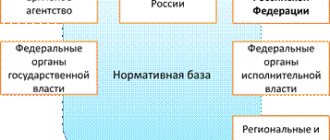Explanation
In laws, articles can be divided into parts, clauses, subclauses and paragraphs.
“Methodological recommendations on the legal and technical preparation of bills” (sent by letter of the Office of the State Duma of the Federal Assembly of the Russian Federation dated November 18, 2003 No. vn2-18/490) determine the recommended procedure for preparing bills. According to these recommendations, the article of the law is divided into:
The parts designated as an Arabic numeral with a dot are 1.
Part of the article may be divided into paragraphs, designated as an Arabic numeral with a closing parenthesis - 1)
The paragraph may be subdivided into subparagraphs, designated by lowercase letters of the Russian alphabet with a closing parenthesis - a)
In exceptional cases, parts, paragraphs and subparagraphs of an article may be divided into paragraphs.
Most modern laws are drawn up in accordance with these recommendations (for example, the Constitution of the Russian Federation, the Criminal Code of the Russian Federation, Federal Law of December 6, 2011 N 402-FZ “On Accounting”).
At the same time, there are exceptions that are not always logically explainable. So, for example, in the Civil Code of the Russian Federation, the article is divided into paragraphs, and not into parts. So, in paragraph 2 of Art. 3 states: “Civil legislation consists of this Code and other federal laws adopted in accordance with it (hereinafter referred to as laws) governing the relations specified in paragraphs 1 and 2 of Article 2 of this Code. ".
In the Tax Code of the Russian Federation, the article is also divided into paragraphs, and not into parts. So, in paragraph 1 of Art. 5 of the Tax Code of the Russian Federation states: “Acts of legislation on taxes and fees specified in paragraphs 3 and 4 of this article may come into force within the time limits directly provided for by these acts, but not earlier than the date of their official publication. ".
Therefore, it is recommended to clarify in the text of the law how the structural units of the article are designated in it.
Example
Federal Law of September 28, 2010 N 244-FZ “On Innovative
Article 5. Ensuring the functioning of the infrastructure of the territory of the Center and life activities on its territory - article
1. In order to ensure the functioning of the infrastructure of the Center territory and life activities on its territory, the management company carries out the following actions: - part
1) prepares documents that, in accordance with this Federal Law, are used instead of an act on the transfer of lands or land plots as part of such lands from one category to another, a master plan for a settlement, land use and development rules, as well as documentation on territory planning based on such documents ; - paragraph
Below is how parts of the article are designated in the main regulations.
Constitution of the Russian Federation
An article of the Russian Constitution can be divided into parts.
Example
Article 1
1. Russian Federation - Russia is a democratic federal legal state with a republican form of government. - Part
Civil Code of the Russian Federation
An article of the Civil Code of the Russian Federation can be divided into clauses and subclauses.
Example
Article 8. Grounds for the emergence of civil rights and obligations - article
1. Civil rights and obligations arise from the grounds provided for by law and other legal acts, as well as from the actions of citizens and legal entities, which, although not provided for by law or such acts, but due to the general principles and meaning of civil legislation give rise to civil rights and obligations . - paragraph
In accordance with this, civil rights and obligations arise:
1) from contracts and other transactions provided for by law, as well as from contracts and other transactions, although not provided for by law, but not contrary to it; - subparagraph
Read more: Civil Code of the Russian Federation
Labor Code of the Russian Federation
An article of the Labor Code of the Russian Federation can be divided into parts. Parts of the article are set out as paragraphs and are not numbered.
Example
Article 10. Labor legislation, other acts containing norms of labor law, and norms of international law - article
Generally recognized principles and norms of international law and international treaties of the Russian Federation in accordance with the Constitution of the Russian Federation are an integral part of the legal system of the Russian Federation. - part 1
If an international treaty of the Russian Federation establishes rules other than those provided for by labor legislation and other acts containing labor law norms, the rules of the international treaty are applied. - part 2
Read more: Labor Code of the Russian Federation
Tax Code of the Russian Federation
An article of the Tax Code of the Russian Federation can be divided into clauses and subclauses.
Example
Article 1. Legislation of the Russian Federation on taxes and fees, legislation of the constituent entities of the Russian Federation on taxes and fees, regulatory legal acts of representative bodies of municipalities on taxes and fees - article
2. This Code establishes a system of taxes and fees, insurance premiums and principles of taxation of insurance premiums, as well as general principles of taxation and fees in the Russian Federation, including: - paragraph
1) types of taxes and fees levied in the Russian Federation; - subparagraph
Read more: Tax Code of the Russian Federation
Budget Code of the Russian Federation
An article of the BC RF can be divided into clauses and subclauses.
Example
Article 20. Classification of budget revenues - article
1. The classification code for budget revenues of the Russian Federation consists of: - paragraph
1) code of the chief administrator of budget revenues; - subparagraph
2) code of the type of income; - subparagraph
Criminal Code of the Russian Federation
An article of the Criminal Code of the Russian Federation can be divided into parts.
Example
Article 2. Objectives of the Criminal Code of the Russian Federation - article
1. The objectives of this Code are: protection of human and civil rights and freedoms, property, public order and public safety, the environment, the constitutional system of the Russian Federation from criminal attacks, ensuring peace and security of mankind, as well as crime prevention.
https://youtu.be/1f5i5MkWLXQ
Civil Procedure Code, N 138-FZ, Article 395 of the Code of Civil Procedure of the Russian Federation
Articles in regulatory legal acts are subject to numbering; Parts (paragraphs) of an article are often numbered. In particular, this is typical for codified acts. The parts of the Constitution of the Russian Federation are numbered. Each article is devoted to one fragment of regulated relationships. Usually it contains one or more interrelated rules of law (or fragments of normative provisions).
The only exception may be the introduction of changes in a generalized form to one article of a legislative act or its structural unit.
But then you have to look for similar references in a new law every time, which is not convenient. I would like to have some kind of universal rule so that one can easily determine how to correctly make references to a particular norm of the law.
Civil relations can be regulated not only by legislative acts, but also by decrees of the President of the Russian Federation (for example, Temporary Regulations on holding companies created during the transformation of state-owned enterprises into joint-stock companies, approved by Decree of the President of the Russian Federation of November 16, 1992 No.
Dividing clauses in parts of an article or in different articles of the same bill into subclauses and paragraphs, which in the text of the clause will follow a colon, is not allowed.
Since we intend to draw up a simple agreement without any frills, we will choose a middle ground so as not to add unnecessary water to the agreement, but also try not to forget anything significant.
Additionally
A normative legal act is a written official document adopted (issued) in a certain form by a law-making body within its competence and aimed at establishing, amending or repealing legal norms.
A code is a law of a codification nature, which combines, on the basis of common principles, norms regulating a certain area of social relations.
Overview of the structure of regulations
Civil Code of the Russian Federation
Labor Code of the Russian Federation
Tax Code of the Russian Federation
Code of the Russian Federation on Administrative Offenses
RUBRICATION AND NUMBERING OF PARTS OF TEXT
The text of the document, with its significant volume, requires division into smaller logically related structural elements.
For scientific and technical texts, document texts, such elements can be: sections, subsections, paragraphs, subparagraphs, parts, chapters, paragraphs, etc. Rubrication is a system of document headings and subsections (headings) headed by them, expressing a logical or other connection and subordination the parts of the text they designate (sections, chapters, paragraphs, etc.). Sections and subsections must have headings. The title of a section (subsection) consists of a number or letter and a thematic part that verbally defines the content or topic of the section, for example:
1. General requirements for equipment
As a rule, paragraphs do not have headings.
Do not put a period at the end of a title placed on a separate line. After the title in the selection with text, a period is required. Other punctuation marks (ellipses, exclamation marks, question marks) are preserved. In a title consisting of two independent, syntactically unrelated sentences, a period is placed between them, and at the end, as a general rule, the period is omitted.
Sections must have serial numbers throughout the document, indicated in Arabic numerals without a dot (requirement of GOST 2.105-95) and written with paragraph indentation. Subsections must be numbered within each section. The subsection number consists of the section and subsection numbers separated by a dot. There is no dot at the end of the subsection number (see Note)
Note In other sources (for example, A.E. Milchin, L.K. Cheltsova. Directory of the publisher and author. Editorial and publishing design of the publication. 2nd edition, corrected and expanded. - M.: OLMA-Press, 2003) indicates on the need to put a period after the serial number of the section and subsection.
Sections, like subsections, can consist of one or more paragraphs.
If the document does not have subsections, then the numbering of paragraphs in it should be within each section. The item number must consist of section and item numbers separated by a dot. There is no dot at the end of the item number (see Note).
If a document has subsections, then the numbering of paragraphs must be within the subsection and the paragraph number must consist of the numbers of the section, subsection and paragraph, separated by dots.
If a section or subsection consists of one paragraph, it is also numbered.
If the text of a document is divided only into paragraphs, they are numbered with serial numbers within the document. Clauses, if necessary, can be divided into subclauses, which must be numbered within each clause, for example: 4.2.1.1, 4.2.1.2, 4.2.1.3, etc.
3. Test methods (third section) 3.1. Apparatus, materials and reagents (first subsection of the third section) 3.1.1. (clause of the first subsection of the third section of the document) 3.2. Preparation for the test (second subsection of the third section) 3.2.1. (clauses of the second subsection of the third section of the document) 3.2.2. . 3.2.2.1. (subparagraphs of the second subsection of the third section of the document) 3.2.2.2. . 3.2.3. (points of the second subsection of the third section of the document)
Listings may be provided within clauses or subclauses. Each listing position is preceded by a hyphen or, if it is necessary to reference one of the listings in the text of the document, a lowercase letter, followed by a parenthesis. To further detail the listings, it is necessary to use Arabic numerals, after which a parenthesis is placed, and the entry is made with a paragraph indentation, for example:
a) text
b) text 1) text 2) text c) text
Each paragraph, subparagraph and enumeration is written with a paragraph indentation.
- an article of law can be divided into parts, clauses, subclauses and paragraphs.









